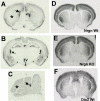Importance of monocarboxylate transporter 8 for the blood-brain barrier-dependent availability of 3,5,3'-triiodo-L-thyronine
- PMID: 19147674
- PMCID: PMC2671898
- DOI: 10.1210/en.2008-1616
Importance of monocarboxylate transporter 8 for the blood-brain barrier-dependent availability of 3,5,3'-triiodo-L-thyronine
Abstract
Mutations of the gene expressing plasma membrane transporter for thyroid hormones MCT8 (SLC16A2) in humans lead to altered thyroid hormone levels and a severe neurodevelopmental disorder. Genetically engineered defect of the Mct8 gene in mice leads to similar thyroid hormone abnormalities but no obvious impairment of brain development or function. In this work we studied the relative role of the blood-brain barrier and the neuronal plasma cell membrane in the restricted access of T(3) to the target neurons. To this end we compared the effects of low doses of T(4) and T(3) on cerebellar structure and gene expression in wild-type (Wt) and Mct8 null male mice [Mct8-/y, knockout (KO)] made hypothyroid during the neonatal period. We found that compared with Wt animals, T(4) was considerably more potent than T(3) in the Mct8KO mice, indicating a restricted access of T(3), but not T(4), to neurons after systemic administration in vivo. In contrast, T(3) action in cultured cerebellar neurons was similar in Wt cells as in Mct8KO cells. The results suggest that the main restriction for T(3) entry into the neural target cells of the mouse deficient in Mct8 is at the blood-brain barrier.
Figures




References
-
- Friesema EC, Grueters A, Biebermann H, Krude H, von Moers A, Reeser M, Barrett TG, Mancilla EE, Svensson J, Kester MH, Kuiper GG, Balkassmi S, Uitterlinden AG, Koehrle J, Rodien P, Halestrap AP, Visser TJ 2004 Association between mutations in a thyroid hormone transporter and severe X-linked psychomotor retardation. Lancet 364:1435–1437 - PubMed
-
- Refetoff S, Dumitrescu AM 2007 Syndromes of reduced sensitivity to thyroid hormone: genetic defects in hormone receptors, cell transporters and deiodination. Best Pract Res Clin Endocrinol Metab 21:277–305 - PubMed
-
- Grüters A 2007 Thyroid hormone transporter defects. Endocr Dev 10:118–126 - PubMed
-
- Visser WE, Friesema EC, Jansen J, Visser TJ 2008 Thyroid hormone transport in and out of cells. Trends Endocrinol Metab 19:50–56 - PubMed
MeSH terms
Substances
LinkOut - more resources
Full Text Sources
Other Literature Sources
Molecular Biology Databases
Research Materials

